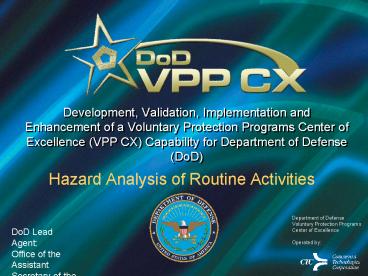Development, Validation, Implementation and Enhancement of a Voluntary Protection Programs Center of - PowerPoint PPT Presentation
1 / 27
Title:
Development, Validation, Implementation and Enhancement of a Voluntary Protection Programs Center of
Description:
Compare and contrast various methods for performing hazard analyses of routine activities ... Reducing the frequency of performing the hazardous task ... – PowerPoint PPT presentation
Number of Views:35
Avg rating:3.0/5.0
Title: Development, Validation, Implementation and Enhancement of a Voluntary Protection Programs Center of
1
Development, Validation, Implementation and
Enhancement of a Voluntary Protection Programs
Center of Excellence (VPP CX) Capability for
Department of Defense (DoD)
- Hazard Analysis of Routine Activities
Department of Defense Voluntary Protection
Programs Center of Excellence Operated by
DoD Lead AgentOffice of the Assistant
Secretary of the Army (Installations and
Environment)
2
Objectives
- After this training you will be able to
- Understand the difference between hazard analysis
and risk analysis - Compare and contrast various methods for
performing hazard analyses of routine activities - Define the benefits of a JHA
- Identify how to address hazards using JHA
- Identify hazard mitigation controls
- Describe hazard prioritization
- Identify the role of Leadership in hazard
analysis.
3
Purpose of Hazard Analysis
- A hazard analysis is the evaluation of the
hazards associated with an employees work
activity - A hazard analysis focuses on fixing the system
or root causes that brought the hazardous
condition or unsafe practice into the workplace - Provides organized approach for the evaluation
of a - process
- Identifies hazards, root causes and corrective
actions. - A hazard analysis attempts to incorporate Safe
Behavior into the normal operating procedures.
4
Hazard Analysis Methods
FMEA
Fault Tree Analysis
5
Hazard Analysis Methods
JHA
JSA
6
Hazard Analysis Benefits
- The hazard analysis
- Increases employee hazard recognition and
awareness - Standardizes operations based on acceptable
safe practices - Identifies appropriate Personal Protective
Equipment (PPE) - Facilitates formal documentation of
employees knowledge of the job requirements.
7
Hazard Analysis for Management
- Management must
- Identify hazards in the workplace that could
result in injury or illness - Evaluate the level of risk to help determine what
controls to implement - Select an appropriate solution to control the
hazard and/or protect - the employee.
8
Hazard Analysis for Employees
- Employees must understand hazard
analysis/analyses is a VPP recognition
requirement - Employees need to be involved in hazard
analysis/analyses from the beginning so - The process that is taking place is better
understood - The value of a change is seen by the employee.
9
Hazard Analysis vs. Self-Inspection
10
Addressing Hazards Using JHAs
11
Job Hazard Analysis
12
Types of Work Place Hazards
13
Root Causes
- Potential causes of injuries include
- Lack of knowledge
- Lack of physical ability
- Prior training that included unsafe practices
- Organizational and cultural perception of what is
acceptable behavior - Previously unidentified hazard
- Newly introduced hazard resulting from process or
equipment change.
14
Addressing Hazards
- Elimination of a specific hazardous work process,
or preventing it from entering the workplace, is
the most effective method of control - Hazards should be eliminated at the development
stage - Substitution should be used when a particularly
dangerous chemical or work process cannot be
completely eliminated.
15
Hazard Mitigation
- Hierarchy of controls to mitigate risk
- Use combination of one or more mitigation
techniques.
16
Engineering Controls
- Engineering controls eliminate exposure to the
hazard by - Isolating the employee from the hazard
- Improving (redesign) work area layout
- Substituting less hazardous product
- Modifying equipment.
17
Administrative Controls
- Administrative controls reduce employee exposure
to a hazard by - Reducing the frequency of performing the
hazardous task - Rotating employees to reduce exposure time
- Training employees to recognize hazards and
employ safety practices.
18
Work Practices
- Work practice controls include
- Workplace rules
- Safe and healthful work practices
- Personal hygiene
- Housekeeping and maintenance
- Procedures for specific operations.
19
PPE
- OSHA requires employers to utilize PPE to reduce
employee exposure to hazards when engineering and
administrative controls are not feasible or
effective - PPE alone should not be relied on to protect
against hazards other uses include guards,
engineering controls, and sound manufacturing
practices.
20
Evaluate Effectiveness
- Assess how well the JHA process is fixing
hazardous conditions by - Updating JHAs for routine and non-routine task
- Ensuring JHAs were developed for all new
processes - Conducting routine self-inspections
- Examining Industrial Hygiene reports
- Reviewing investigation findings for injuries
and near misses - Following up on employee concerns.
- Incorporate evaluation into Annual Program
Evaluation process.
21
Hazard Prioritization
22
Hazard Prioritization
- Severity is the classification of deficiencies
that indicate the level of harm caused by the
hazard - Probability is the extent to which something is
likely to happen.
23
Residual Risk
- After controls are put into place, remaining risk
requires appropriate level approval authority to
accept risk to continue operation/process - Approval authority is defined by organizational
structure or by regulation - Increasing level of approval hierarchy is
required for progressively higher levels of risk.
24
Leadership Role
25
Leadership Role
- Prioritize hazard analysis process based on risk
- Actively support employee participation in
identification of work related hazards - Monitor programs to address identified risks
- Create fix the system safety culture.
26
Summary
- In this section you learned about
- The difference between hazard analysis and risk
analysis - Various methods for performing hazard analyses of
routine activities - The benefits of a JHA
- How to address hazards using JHA
- Hazard mitigation controls
- Hazard prioritization
- The role of Leadership in hazard analysis.
27
Questions?































